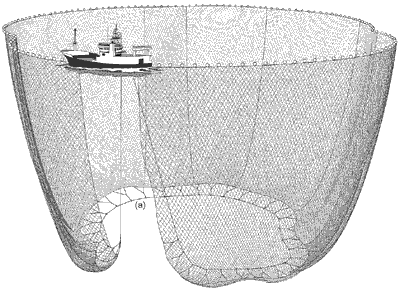EUROPEAN CETACEAN BYCATCH CAMPAIGN
"Man is but a strand in the complex web of life"
"Man is but a strand in the complex web of life"
Purse Seine Netting
(Courtesy of Scottish Executive)
2.12 Purse seiners capture large aggregations of pelagic fish that shoal in midwater or near the surface by surrounding these concentrations with a deep curtain of netting which is supported at the surface by floats (Figure 12).
Small lead weights on the underside of the curtain ensure that the leadline quickly sinks and the net is then pursed under the shoal by heaving on a wire or purseline (a) which runs through steel rings attached to the lower edge of the net.
When the gear is closed and fish can no longer escape the netting is hauled lengthways using a mechanised power block until the fish are packed tightly in the bunt, or last remaining section of the net to be hauled.
The fish are then pumped or brailed aboard the vessel. A large purse seine can be as long as 1 kilometre and 200 metres deep.
Purse seiners generally try to avoid bottom contact as the small mesh nylon netting is easily damaged. A purse seine is not strictly speaking a towed gear but the purseline wire, being probably the strongest subsurface component, could possibly foul and cause damage to underwater installations.
Typical (and maximum) values for pursing wire diameters are 26mm (28mm) of 6/24 fibre core construction although 6/26 dyeform compacted wires with both fibre and steel cores are also used.
Figure 12. Purse seine
